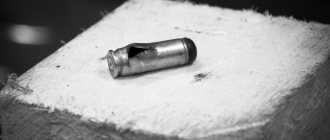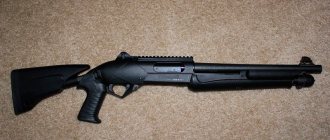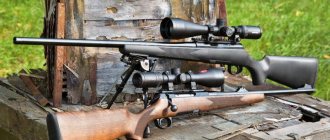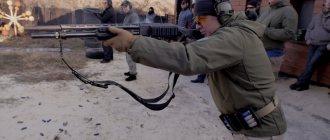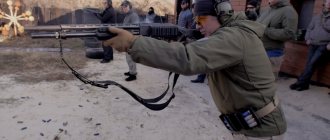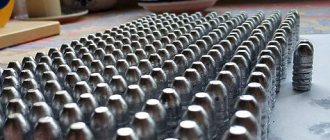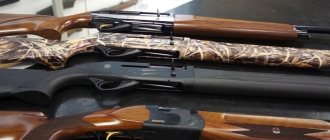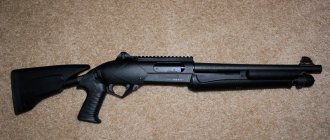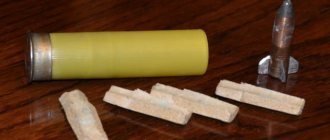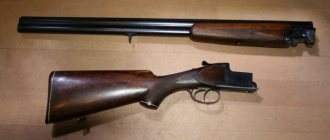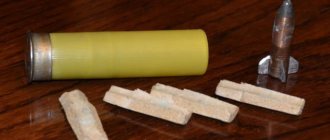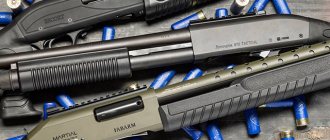Photo: Kalashnikov Concern
The results of the All-Russian competition “100 Best Products of Russia 2020” have been summed up. Kalashnikov products won prizes in the Industrial Goods for the Population category. The TG2 smoothbore carbine and the Baikal 141 Sobol hunting carbine received the gold award. TR3 and Baikal 145 Los carbines received Silver. Read about the best Russian weapons for hunters in our material.
Prototypes.
Experimental pistol - machine gun model 1942.
The submachine gun was tested at the Shchurovsky training ground. The commission’s conclusion noted that it is more complex and more expensive than PPSh-41 and PPS, and requires the use of scarce and slow milling work. It was not accepted for service. Caliber - 7.62 mm. Built on the principle of a semi-free shutter. The impact mechanism is of the striker type, powered by a return spring. The trigger mechanism allows for both single and continuous fire. The flag-type translator, located on the left side of the trigger frame, simultaneously serves as a safety lock, locking the trigger. Extraction and reflection of the spent cartridge case is carried out using an ejector mounted on the bolt and a reflector rigidly fixed to the bottom of the trigger frame. The cartridges are fed from a box-shaped double-row magazine with 30 rounds. The submachine gun is equipped with a metal folding butt, a wooden pistol grip and an additional handle for holding while firing, located on the barrel casing. The front end of the barrel casing serves as a compensator brake.
Experienced light machine gun model 1943
Caliber - 7.62 mm. Tested at the Shchurovsky training ground in 1943. It was not accepted for service.
Experimental self-loading carbine, model 1944.
Caliber - 7.62 mm. Tested at the Shchurovsky training ground in 1943. It was not accepted for service.
Experienced submachine gun mod. 1947
Caliber - 9 mm. Automation is based on the recoil of the free shutter. The trigger mechanism allows for both single and continuous fire. The translator simultaneously performs the function of a fuse. The extraction and reflection of the spent cartridge case is carried out using an ejector mounted on the bolt and a reflector rigidly mounted on the side wall of the receiver. The cartridges are fed from a double-row box magazine, which is used when firing as an additional handle to hold the submachine gun. A sight with a rotating rear sight for shooting at distances of 100 and 200 m. The submachine gun is equipped with a retractable metal butt, which in the stowed position slides into the receiver, and a pistol-type wooden handle.
It was not accepted for service.
Pros and cons of VPO 209
Now about the pros and cons of weapons.
Pros:
- This weapon is completely identical to the Kalashnikov assault rifle - it is a cult weapon that cannot be treated indifferently;
- Shooting at 150-200 meters according to the product passport is a sufficient distance to gain accurate shooting skills; these distances are also suitable for hunting and sports;
- High energy ammunition, excellent stopping effect on large animals - the .366TKM caliber cartridge is identical to the 7.62x39 cartridge, and even slightly exceeds it in terms of energy.;
- Wide selection of ammunition, the ability to load cartridges yourself - there is a lot of ammunition in caliber with all types of bullets, there are even shot cartridges;
- Interchangeability of tuning elements and some spare parts with weapons on the AK platform - you can install telescopic stocks, optics and a tubular forend from any popular body kit manufacturer on it.
Minuses:
- This weapon is completely identical to the Kalashnikov assault rifle - if this is not your first Kalashoid, or you don’t like weapons on the AK platform at all, then you will not be delighted;
- Large weight for running hunting - if you plan to exclusively hunt, then let's be honest - there are much more suitable weapons for this, lighter and more practical;
- Strong bullet drop after a distance of 200 meters - at long distances, all weapons in Lancaster and Paradox fire like a mortar, along a very steep trajectory. Hunting or quick shooting at the limit of the maximum distance requires quickly setting corrections in large increments, which is not always convenient;
- Strong recoil and kick - the 7.62x39 caliber had excess energy for a weapon of AK dimensions, and the .366TKM cartridge has even more. Get ready for VPO 209 to kick you pretty hard;
- Expensive ammunition compared to rifled weapons - again, compared to 7.62x39, the .366 TKM cartridge is three times more expensive. For hunting this is not significant, but this price will hit the athlete’s pocket noticeably - during training you have to shoot 200-300 rounds of ammunition. Some shooters try to solve this problem by reloading cartridges - fortunately, everything is commercially available for this, from cartridge cases to bullet cartridges.
Samples of weapons adopted for service.
Kalashnikov assault rifle model 1947 AK-47
Caliber: 7.62 mm Weight: 4.86 kg Total length: 870 mm Sighting range: 800 m Initial bullet speed: 700 m/s Rate of fire: 600 rounds/min Practical rate of fire: 40/90-100 Magazine capacity: 30
Adopted by the Soviet Army in 1949. Serially produced from 1949 to 1957. in two versions - with a permanent and folding metal butt. The automatic action is based on the use of the energy of part of the powder gases removed from the barrel. The barrel bore is locked by two lugs when turning due to the interaction of the bolt release with the figured groove of the bolt frame; cartridges are supplied from a 30-place sector magazine. The trigger magazine allows for single and automatic fire; the machine gun is equipped with a removable bayonet.
Kalashnikov assault rifle modernized AKM
Caliber: 7.62 mm Weight: 3.6 kg Total length: 880 mm Sighting range: 800 m Initial bullet speed: 715 m/s Rate of fire: 600 rounds/min Practical rate of fire: 40/90-100 Magazine capacity: 30
It was put into service in 1959. Modernization was aimed primarily at increasing the accuracy of fire, reducing the weight of the weapon and reducing the cost of production. It differs from the AK-47 in its receiver, made by stamping from thin sheet metal. A new part was introduced into the trigger mechanism - a fire rate retarder. Also, a muzzle compensator was developed for the AKM, which increased the accuracy of fire from unstable positions (without a rest). Like the AK-47, it had a variant with a folding metal stock - AKMS.
Kalashnikov RPK light machine gun
Caliber: 7.62 mm Weight: 5.6 kg Total length: 1040 mm Sighting range: 1000 m Muzzle velocity: 745 m/s Rate of fire: 600 rounds/min Practical rate of fire: 40/150 Magazine capacity: 40/75
In the mid-1950s, the Soviet Union decided to unify the small arms system at the platoon level. As a result, the Kalashnikov AKM assault rifle and the Kalashnikov light machine gun were adopted. Most of the new machine gun was interchangeable with the AKM. The barrel has undergone changes; it has been lengthened to increase the firing range and made heavier to reduce overheating during prolonged shooting. To increase stability, the machine gun was equipped with a folding bipod and a butt with a protrusion for supporting it with the left hand. The cartridges were fed from a 40-round sector magazine or a 75-round drum magazine.
Kalashnikov assault rifle model 1974 AK-74
Caliber: 5.45 mm Weight: 3.6 kg Total length: 940 mm Sighting range: 1000 m Initial bullet speed: 900 m/s Rate of fire: 600 rounds/min Practical rate of fire: 40/100 Magazine capacity: 30
Adopted into service in 1974. It differs from previous AK models with a new 5.45 mm caliber cartridge. The need to switch to a new cartridge was caused by the desire to further improve the accuracy of automatic fire of small arms. The characteristic appearance of the AK-74 was given by a two-chamber muzzle compensator, which significantly reduced recoil and reduced upward deflection of the barrel. The AKS-74 variant was equipped with a frame stock, which folded onto the left side of the receiver.
Kalashnikov assault rifle with folding stock and shortened barrel AKS-74U
Caliber: 5.45 mm Weight: 3.0 kg Total length: 730 mm Sighting range: 500 m Initial bullet speed: 735 m/s Rate of fire: 600 rounds/min Practical rate of fire: 40/100 Magazine capacity: 30
The shortened Kalashnikov AKS-74U assault rifle was created on the basis of the AKS-74 and entered service in 1979. Its creation is an attempt to combine in one model the high firepower of an assault rifle with the small dimensions and weight of a submachine gun. The assault rifle differs from the AKS-74 in its barrel length reduced by almost half; at the same time, in order to maintain acceptable accuracy characteristics, it was necessary to reduce the rifling pitch. The machine's front sight block is combined with the gas chamber, and the base of the sight is shifted back and located on the receiver cover. The sighting bar has been replaced by a reversible rear sight with two distances. To reduce the muzzle flame, the machine is equipped with a flame arrester.
Kalashnikov light machine gun model 1974 RPK-74
Caliber: 5.45 mm Weight: 5.46 kg Total length: 1060 mm Sighting range: 1000 m Initial bullet speed: 900 m/s Rate of fire: 600 rounds/min Practical rate of fire: 50/100 Magazine capacity: 45
With the adoption of the AK-74, a light machine gun of 5.45x39 caliber was created. The machine gun was serially produced at the Vyatsko-Polyansky Machine-Building Plant.
Kalashnikov assault rifle model 1991 AK-74M
Caliber: 5.45 mm Weight: 3.6 kg Total length: 940 mm Sighting range: 1000 m Initial bullet speed: 900 m/s Rate of fire: 600 rounds/min Practical rate of fire: 40/100 Magazine capacity: 30
The modernization of the AK-74 was carried out in 1991. In the modernized model, the butt, fire control handle, fore-end and receiver lining are made of high-tech injection molded plastic glass-filled polyamide. On the left side of the receiver there is a base for installing night, optical or collimator sights.
Kalashnikov assault rifle series 100, AK-101
Caliber: 5.56 mm Weight: 3.8 kg Total length: 943 mm Sighting range: 1000 m Initial bullet speed: 910 m/s Rate of fire: 600 rounds/min Practical rate of fire: 40/100 Magazine capacity: 30
Developed on the basis of the AK-74 and chambered for the standard NATO cartridge of 5.56×39 mm caliber. Intended for export.
Kalashnikov assault rifle series 100, AK-103
Caliber: 7.62 mm Weight: 3.8 kg Total length: 943 mm Sighting range: 1000 m Initial bullet speed: 715 m/s Rate of fire: 600 rounds/min Practical rate of fire: 40/100 Magazine capacity: 30
Developed on the basis of the AK-74 chambered for 7.62×39 mm caliber. Intended for export.
Kalashnikov assault rifle series 100, AK-105
Caliber: 5.45 mm Weight: 3.5 kg Total length: 824 mm Sighting range: 500 m Initial bullet speed: 840 m/s Rate of fire: 600 rounds/min Practical rate of fire: 40/100 Magazine capacity: 30
Developed on the basis of the AK-74 and represents its shortened version. Intended for export.
Kalashnikov machine gun PK, Kalashnikov machine gun modernized PKM
Caliber: 7.62×54 Weight without the machine: 7.5 kg With a belt for 200 rounds: 15.5 kg Weight on the machine without cartridges: 12 kg Length on the machine: 1270 mm Sighting range: 1500 m. Rate of fire: 650 rds. /min
The Kalashnikov machine gun was put into service in 1961 and modernized in 1969. The machine gun belongs to the so-called “single machine guns,” that is, it can be used in manual and easel versions (when installed on a tripod machine). The cartridges are fed from a link belt with closed links. The operating principle of automation is the use of energy from exhaust powder gases. Locking is done by turning the bolt to two lugs. The trigger mechanism is striker-type and provides only automatic firing.
Kalashnikov tank machine gun PKT, Kalashnikov tank machine gun modernized PKTM
Caliber: 7.62×54 Weight: 11.75 kg Length: 1100 mm Rate of fire: 650 rounds/min
The Kalashnikov tank machine gun is intended for arming tanks and other armored vehicles. It entered service in 1962 and was modernized in 1969. It differs from the PC in the electric trigger for remote fire control, a different design of the gas regulator, and the absence of mechanical sighting devices. The machine gun was serially produced at the Zlatoust Machine-Building Plant.
Hunting rifled and smoothbore carbines "Saiga"
In the early 1990s, during the conversion period, the state order for military weapons sharply decreased and the Izhmash team began developing the Saiga family of hunting carbines based on army weapons. As a result, in 1992, the development was completed and mass production of self-loading Saiga hunting carbines chambered for a hunting cartridge was organized on the production lines of the Kalashnikov assault rifle.
The change in the design of the weapon affected primarily the trigger mechanism: parts that ensure automatic firing were removed from it; In addition, the location of the remaining parts has been changed so that the process of reassembly into a military weapon is impossible. The design of the magazine receiving window has also been changed: it is now impossible to attach a magazine to it from a machine gun. The safety remains the same - not only does it reliably lock the trigger, but it also does not allow the bolt frame to be completely retracted; in addition, it covers the bolt cutout, protecting the inside of the receiver from clogging.
The production of Saiga carbines was organized with minimal changes in technological processes and limited production of original parts. The increase in the production of hunting carbines occurred against the background of a further reduction in the production of Kalashnikov assault rifles. Izhevsk rifled and smooth-bore weapons, made in the layout of a Kalashnikov assault rifle, have found their interested consumers in many countries around the world.
Self-loading hunting carbine "Saiga - 5.6C"
Caliber: 5.6×39 Carbine weight: 3.6 kg Length: 985 mm Total length with stock folded: 745 mm Barrel length: 520 mm Magazine capacity: 10 rounds
The Saiga 5.6C carbine was developed in the second half of the 1990s. and is intended for commercial and amateur hunting of small and medium-sized animals. This model has an elongated barrel, as well as a pistol grip and a folding stock, made like an AK-74M assault rifle. The magazine capacity and the design of the plastic forend are close to “hunting” standards. The trigger mechanism has a lock that prevents a shot when the butt is folded.
Smoothbore self-loading carbine "Saiga-410"
Caliber: .410 Cartridge: 410/70, 410/76, 410 Magnum Weight: 3.4 kg Length: 1160 mm Barrel length 570 mm Magazine capacity: 2,4,10 rounds Stock type: permanent
The Saiga-410 model appeared in 1994 and is made for the smallest shot caliber .410 (10.41 mm). Designed for hunting small and medium-sized animals and birds. The carbine bolt is made in accordance with the characteristics of the rifle cartridge. The permanent stock of the Saiga-410 has a pistol-shaped neck protrusion and, like the fore-end, is made of wood or high-strength plastic.
Smoothbore self-loading carbine "Saiga-20"
Caliber: 20 Cartridge: 20x70, 20x76 Weight without magazine: 3.4 (3.7) kg Length: 1135 mm Barrel length: 570 (670) mm Magazine capacity: 5,8,10 rounds Stock type: permanent
The Saiga-20 model with a 20-gauge barrel and a 70 or 76 mm long chamber for bullet or shotgun cartridges appeared in 1995 and is intended for hunting medium and large animals. The carbine has a permanent hunting-type butt, but can also be equipped with a quick-release butt, instead of which a pistol grip is placed. To regulate the effect of powder gases on automatic parts when firing, a regulator (“plug”) was introduced into the gas outlet unit. As a modification, the Saiga-20 can have a barrel extended to 670 mm.
Smoothbore self-loading carbine "Saiga - 12"
Caliber: 12 Cartridge: 12/70, 12/76 Weight without magazine: 3.6 (3.8) kg Length: 1145 (1245) mm Barrel length: 580 (680) mm Magazine capacity: 5.8 rounds Stock type: constant
Since 1996 The Izhevsk Machine-Building Plant produces smooth-bore self-loading carbines "Saiga-12". Carbines are designed for hunting medium and large animals. These models use interchangeable choke tubes with various constrictions and a rifled version of the “Paradox” type nozzle. The butt and fore-end can be made of wood or plastic. For ease of transportation and increased maneuverability, the Saiga-12 can be equipped with a quick-release stock and handle.
Self-loading hunting carbine "Saiga - 308"
Caliber: 7.62 mm Cartridge: 7.62×51 (.308 Win) Carbine weight: 4.1 kg Overall length: 1125 mm Barrel length: 555 mm Magazine capacity: 5.8 rounds
The Saiga-308 carbine is distinguished by the use of a 7.62×51 cartridge (.308 Winchester). Developed in 1996 and used for hunting medium and large animals. The carbine bolt has three lugs and a spring-loaded firing pin. The handguard is of a hunting type, expanding at the bottom. The barrel is cold forged, with a chrome-plated bore and chamber. A shock absorber is installed on the back of the butt, and a slotted flash suppressor is installed on the muzzle of the barrel. The butt on the Saiga-308 carbine is made quick-detachable.
Self-loading hunting carbine "Saiga - 9"
Cartridge: 9×53R Carbine weight: 3.9 kg Total length: 1125 mm Barrel length: 555 mm Magazine capacity: 5 rounds
In order to expand the range of powerful 9-mm weapons for shooting at ranges up to 150-200 m at large animals, the Saiga-9 carbine chambered for the 9×53R cartridge was developed in 1998. The Saiga-9 carbine is generally similar in design to the Saiga-308-1 model with a permanent wooden butt and a hunting-type fore-end, but differs from it in the barrel chambered for the large-caliber 9×53R hunting cartridge.
Application
Monitoring reviews from Saiga owners showed that user opinions differed. Hunters believe that this weapon did not make a good rifle for hunting. They attribute this to the short barrel, complaining about the inability to hit moving game with a converted machine gun offhand and at a considerable distance. For these purposes, a double-barreled shotgun is better suited, whose barrel is much longer and the weapon is noticeably lighter.
For large animals, the Saiga carbine is undoubtedly better suited, especially at close range, when a wounded animal attacks the hunter.
However, there is an option in the line of this type of shotgun for long-distance hunting, this is the Saiga 12 carbine. 061. This type ranks second in range, behind the Saiga, with a barrel length of 680 mm.
The impressive appearance and positive characteristics of close combat allow the Saiga 12C carbine to deservedly occupy an honorable place among self-defense weapons and is in service with special units of the Russian Ministry of Defense.
Also, this weapon is widely used by security structures.
Saiga-12 isp.030 is used by the national department for combating drug trafficking as the standard weapon of fighters.
Hunting rifled carbines "Vepr"
In the early 1990s, during the conversion period, the state order for military weapons sharply decreased. The problems of maintaining production facilities in working order in the absence of orders, maintaining the staff of gunsmiths, required the development and development of civilian weapons using technologies for large-scale production of military weapons. As a result, the Vyatsko-Polyansky Machine-Building team began developing a hunting carbine based on the Kalashnikov light machine gun.
In 1995, serial production of Vepr self-loading hunting carbines was organized. The change in the design of the new weapon model, like the Saiga hunting carbines produced in Izhevsk, affected primarily the trigger mechanism: parts that ensure automatic firing were removed from it. In addition, the location of the remaining parts has been changed so that the process of reassembly into a military weapon is impossible.
The production of Vepr carbines was organized with minimal changes in technological processes and limited production of original parts. Against the background of the abundance of various weapons produced in the world, Vepr carbines have found their interested consumers both in the domestic market of Russia and abroad. Gradually, a whole family of hunting weapons was developed, in which new modifications are constantly appearing, some of which are shown below.
Self-loading hunting carbine "Vepr"
Caliber: 7.62 mm Cartridge: 7.62×39 Weight: 4.3 kg Length: 1010; 1180 mm Barrel length: 420; 520; 590 mm Magazine capacity: 5 rounds
Self-loading hunting carbine "Vepr". Produced since 1995 and is the founder of the entire series of hunting carbines. The new model inherited from the light machine gun a reinforced receiver and a heavy barrel with a chrome-plated bore and chamber for increased durability. The sector sight with a mechanism for introducing lateral corrections was also retained. To eliminate possible inertial pinching of the primer on imported cartridges, the bolt striker is spring-loaded. The stock is combined, with a pistol grip and a rubber butt pad. To increase safety, the Vepr carbine is equipped with a flag-type fuse. The weapon can be equipped with an optical sight.
Self-loading hunting carbine "Vepr-308"
Caliber: 7.62 mm Cartridge: 7.62×51; (.308 Win) Carbine weight: 4.3 kg Length: 1080; 1150 mm Barrel length: 520; 590 mm Magazine capacity: 5; 10 rounds
With such a mass of weapons, the 7.62x39 cartridge turned out to be insufficiently powerful, so in 1996 the Vepr-308 carbine appeared chambered for 7.62x51 and 7.62x51M cartridges of domestic and foreign production (.308 Winchester). This cartridge has significantly expanded the scope of use of the Vepr-308 carbine in various types of hunting. This model has become the main one and is available in various versions. For greater locking strength, the bolt has three lugs. The flash suppressor for the Vepr-308 resembles the flash suppressor of the SVD sniper rifle. In addition, the gas outlet unit has been improved.
Self-loading hunting carbine "Vepr-308 Super"
Caliber: 7.62 mm Cartridge: 7.62×51 (.308 Win) Carbine weight: 4.2 kg Length: 1010; 1080 mm Barrel length: 550; 650 mm Magazine capacity: 5; 10 rounds
The Vepr-308 Super carbine has been produced since 1998. This model is the first to use a one-piece stock instead of a separate stock and forearm. The front sight block is moved from the muzzle of the barrel and placed on the gas chamber. The carbine uses a new installation and fastening scheme for the magazine and optics, and the magazine ejection mechanism has been improved. To increase safety, the Vepr-Super series carbine is equipped with a convenient push-button safety. The front part of the barrel with radially inclined holes serves as a muzzle compensator-flash suppressor. Taking into account the predominant use of optical sights with carbines, the length of the sighting line was reduced, and the sector sight was replaced with a reversible rear sight for shooting at distances of 100 m and 300 m.
Self-loading hunting carbine "Vepr-223"
Caliber: 5.56 mm Cartridge: 5.56×45 (.223 Rem) Carbine weight: 4.3 kg Length: 1010; 1080 mm Barrel length: 420; 520; 590 mm Magazine capacity: 5; 10 rounds
The Vepr-223 self-loading hunting carbine has been produced since 2000. It is a modification of the Vepr-308 model and has the same main components and parts. The main difference is the use of the 5.56x45 or .223 Remington cartridge. The bolt on the Vepr-223 carbines is locked by turning the bolt through two lugs, unlike more powerful modifications.
Self-loading hunting carbine "Vepr-Pioneer"
Caliber: 7.62; 5.56 mm Cartridge: 7.62×39; 5.56×45 (.223 Rem) Carbine weight: 3.9 kg Length: 1040 mm Barrel length: 550 mm Magazine capacity: 5; 10 rounds
Following other models of carbines, the lightweight carbine “Vepr-Pioneer” was developed, produced since the early 2000s. While maintaining the general basic design, the carbine has a number of differences: the receiver is shortened, the gas tube does not separate during disassembly. The trigger mechanism is mounted on a separate, easily detachable base (trigger guard), in the front of which a latch for a replaceable box magazine is mounted. The stock of the carbine is solid, wooden, with a pistol grip on the neck of the butt, a ridge on the butt and a shock absorber on the back of the stock, and a wide fore-end. The front sight block is combined with the gas chamber. A two-position reversible rear sight allows for targeted shooting at distances of 100 and 300 m. To increase safety, the Vepr-Pioneer carbines are equipped with a convenient push-button safety.
Self-loading hunting carbine "Vepr-Hunter M"
Caliber: 7.62 mm Cartridge: .308 Win (7.62×51); .30-06 Sprg (7.62×63) Carbine weight: 4.0 kg Length: 1090 mm Barrel length: 550 mm Magazine capacity: 2; 3; 5; 10 rounds
The Vepr-Hunter carbine is another development of a hunting weapon. It uses a modified design of the trigger mechanism; a two-position push-button safety is located in the trigger mechanism housing. The gas exhaust mechanism is equipped with a regulator, the appearance of which is caused by the variety of cartridges used. The optical sight bracket with side mounting allows you to shoot from an open sight without removing the optical sight. Two main modifications of carbines are produced: “Vepr-Hunter” - a barrel with a slot-type muzzle brake, the front sight block is combined with a gas chamber; "Vepr-Hunter M" - a barrel without a muzzle brake, the front sight block is located at the muzzle. The stock is made according to the Monte Carlo type.
Criteria for choosing a gun
Hunting weapons are intended exclusively for hunting animals. For self-defense, gas cartridges, stun guns, traumatic and pneumatic models are sold. If a stranger attacks and threatens to kill, you can shoot him with a firearm. However, in the event of the death of the attacker, you will have to prove in court that the degree of self-defense was not exceeded. For exceeding the permissible limit of self-defense, you can get a real prison sentence.
Usually, for self-defense, they buy single-barreled guns that look like a Kalashnikov assault rifle. At the sight of such a formidable weapon, the attacker will immediately want to run away. In addition, semi-automatic rifles fire loudly. The sound of a gunshot alone can scare off a robber. It is not necessary to shoot a person.
If you load the magazine in advance, the shooter will not have to waste time reloading. The semi-automatic model's box chamber holds 5-10 rounds, with all ammunition at the ready. After the shot is fired, the next projectile is automatically sent from the magazine into the barrel. True, this happens until all the ammunition inserted into the chamber runs out.
Self-loading carbines have a good rate of fire and high destructive power. If you shoot at a person from a distance of up to 10 meters, you can kill him. True, self-loading shotguns are sensitive to the quality of ammunition. Rubber (weak) shells cannot be used instead of powder bullets. But you can load 2-3 magazines with ammunition in advance and change them when shooting.
Storing a loaded gun at home is also prohibited. It is advisable to practice in advance how to assemble and disassemble a weapon at speed and, if necessary, quickly bring the semi-automatic weapon into combat condition.
